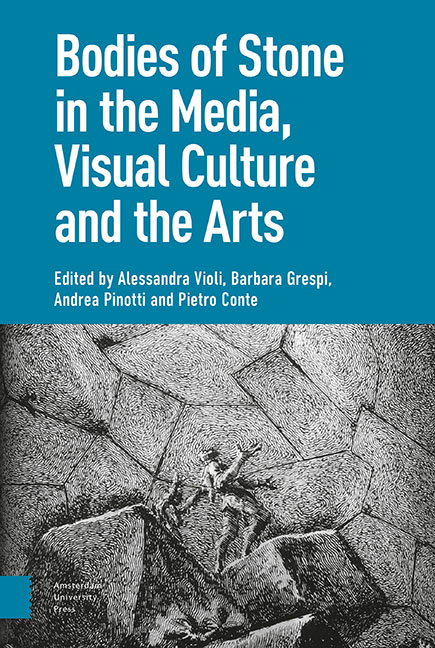Book contents
- Frontmatter
- Contents
- Introduction: Learning from Stone
- I Statue: The Imaginary of Uncertain Petrification
- 1 Theatre and Memory: The Body-as-Statue in Early Modern Culture
- 2 Translated Bodies: A ‘Cartographic’ Approach
- 3 Pantomime in Stone: Performance of the Pose and Animal Camouflage
- 4 Animated Statues and Petrified Bodies: A Journey Inside Fantasy Cinema
- 5 The Ephemeral Cathedral: Bodies of Stone and Configurations of Film
- II Matter: Size, Hardness, Duration
- 1 Bodies That Matter: Miniaturisation and the Origin(s) of ‘Art’
- 2 Brancusi’s ‘Sculpture for the Blind’
- 3 Cinema, Phenomenology and Hyperrealism
- 4 Ephemeral Bodies: The ‘Candles’ of Urs Fischer
- 5 The Celluloid and the Death Mask: Bazin’s and Eisenstein’s Image Anthropology
- III Corpse: Fossils, Auto-Icons, Revenants
- 1 Funeral Eulogy: Post-Mortem Figures and Redeemed Bodies, in Images
- 2 On Jack Torrance As a Fossil Form
- 3 Technical Images and the Transformation of Matter in Eighteenth-Century Tuscany
- 4 Glass, Mixed Media, Stone: The Bodily Stuffs of Suspended Animation
- 5 Bodies’ Strange Stories: Les Revenants and The Leftovers
- IV Monument: Embodying and Grafting
- 1 The Impassibly Fleshly, the Statue of the Impossible
- 2 Frozen into Allegory: Cleopatra’s Cultural Survival
- 3 The Orphan Image
- 4 The Well-Tempered Memorial: Abstraction, Anthropomorphism, Embodiment
- 5 Monuments of the Heart: Living Tombs and Organic Memories in Contemporary Culture
- Index
5 - Monuments of the Heart: Living Tombs and Organic Memories in Contemporary Culture
Published online by Cambridge University Press: 20 November 2020
- Frontmatter
- Contents
- Introduction: Learning from Stone
- I Statue: The Imaginary of Uncertain Petrification
- 1 Theatre and Memory: The Body-as-Statue in Early Modern Culture
- 2 Translated Bodies: A ‘Cartographic’ Approach
- 3 Pantomime in Stone: Performance of the Pose and Animal Camouflage
- 4 Animated Statues and Petrified Bodies: A Journey Inside Fantasy Cinema
- 5 The Ephemeral Cathedral: Bodies of Stone and Configurations of Film
- II Matter: Size, Hardness, Duration
- 1 Bodies That Matter: Miniaturisation and the Origin(s) of ‘Art’
- 2 Brancusi’s ‘Sculpture for the Blind’
- 3 Cinema, Phenomenology and Hyperrealism
- 4 Ephemeral Bodies: The ‘Candles’ of Urs Fischer
- 5 The Celluloid and the Death Mask: Bazin’s and Eisenstein’s Image Anthropology
- III Corpse: Fossils, Auto-Icons, Revenants
- 1 Funeral Eulogy: Post-Mortem Figures and Redeemed Bodies, in Images
- 2 On Jack Torrance As a Fossil Form
- 3 Technical Images and the Transformation of Matter in Eighteenth-Century Tuscany
- 4 Glass, Mixed Media, Stone: The Bodily Stuffs of Suspended Animation
- 5 Bodies’ Strange Stories: Les Revenants and The Leftovers
- IV Monument: Embodying and Grafting
- 1 The Impassibly Fleshly, the Statue of the Impossible
- 2 Frozen into Allegory: Cleopatra’s Cultural Survival
- 3 The Orphan Image
- 4 The Well-Tempered Memorial: Abstraction, Anthropomorphism, Embodiment
- 5 Monuments of the Heart: Living Tombs and Organic Memories in Contemporary Culture
- Index
Summary
Abstract
According to the basic assumption that monuments are the aesthetic mediators of memory—primarily the memory of the dead—the essay aims to discuss the imaginary of the body as a sepulchral monument. Taking as a starting point the legend of Artemisia of Caria, who celebrated the memory of her dead husband/brother Mausolus both by having the Mausoleum of Halicarnassus erected and by drinking Mausolus’ ashes so as to turn herself into his living sarcophagus, the analytic focus is on the replication of similar symbolic practices in contemporary culture, namely in the field of organ transplantation. The transplanted patient receives and preserves within his/her body the organ of the deceased donor, thus becoming, even if unintentionally, the donor's memorial monument.
Keywords: Artemisia of Caria; cannibalism; organ transplantation; living monument
The act of remembering is an affair of the heart from the very beginning: the Latin root of the word recŏrdari, ‘to remember’,means ‘putting back (re) in the heart (cor, cordis)’, i.e. passing a segment of time back to the organ that the ancients believed to be the seat of memory ‘as though the past was thus sutured […] to the heart.’
This symbolic suture f inds its concretisation today, when organ transplantation surgery sews the heart of a deceased person into the body of another, attaching it to a different anatomical structure which keeps it alive but which also seems to remember the affective, intuitive and communicative energies of the individual it belonged to. Indeed, despite the scepticism of mainstream medicine, many patients claim, not without anguish, to have changed tastes, habits and lifestyles after the transplantation of the heart or of other internal organs, as if the latter had transformed their bodies into reliquaries of the donor's memories and personality.
The cultural imaginary of organ transplantation is marked by this organic remembering which acts through the body, thus calling into question all the individual barriers that had been theorised with the discovery of cellular immunity in the nineteenth century. According to cellular immunity theory, human anatomy corresponded to a well-circumscribed organism, limited and protected by specific biological frontiers, firmly defending the identity of the individual.
- Type
- Chapter
- Information
- Bodies of Stone in the Media, Visual Culture and the Arts , pp. 343 - 360Publisher: Amsterdam University PressPrint publication year: 2020

